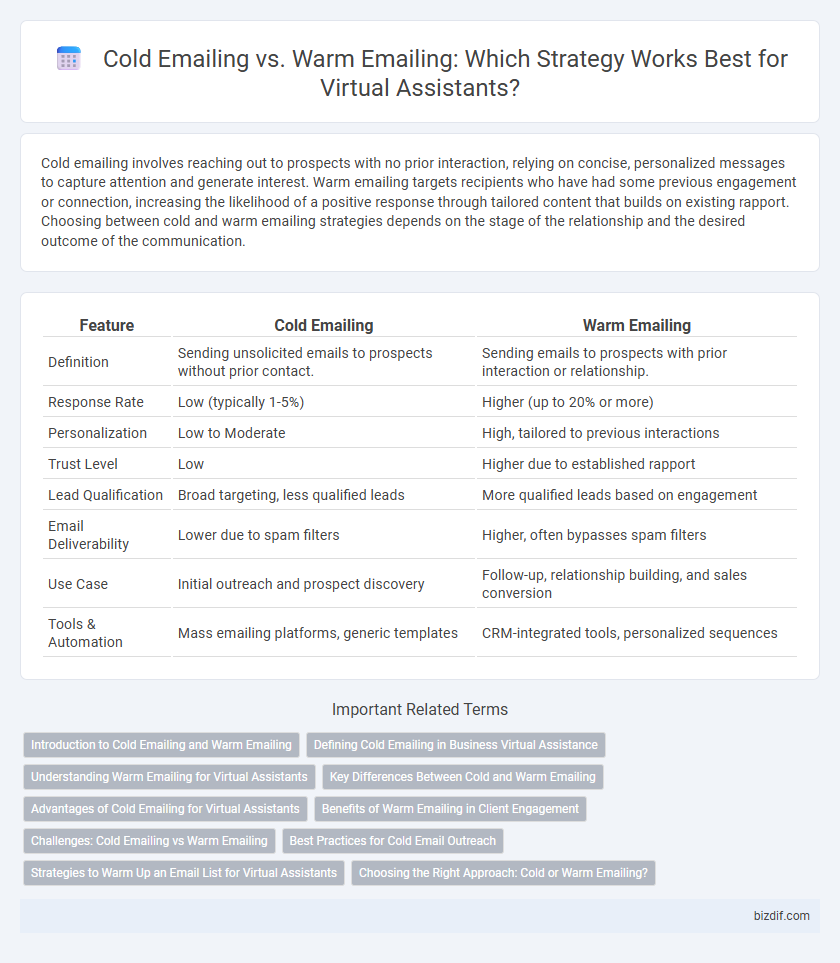Cold emailing involves reaching out to prospects with no prior interaction, relying on concise, personalized messages to capture attention and generate interest. Warm emailing targets recipients who have had some previous engagement or connection, increasing the likelihood of a positive response through tailored content that builds on existing rapport. Choosing between cold and warm emailing strategies depends on the stage of the relationship and the desired outcome of the communication.
Table of Comparison
| Feature | Cold Emailing | Warm Emailing |
|---|---|---|
| Definition | Sending unsolicited emails to prospects without prior contact. | Sending emails to prospects with prior interaction or relationship. |
| Response Rate | Low (typically 1-5%) | Higher (up to 20% or more) |
| Personalization | Low to Moderate | High, tailored to previous interactions |
| Trust Level | Low | Higher due to established rapport |
| Lead Qualification | Broad targeting, less qualified leads | More qualified leads based on engagement |
| Email Deliverability | Lower due to spam filters | Higher, often bypasses spam filters |
| Use Case | Initial outreach and prospect discovery | Follow-up, relationship building, and sales conversion |
| Tools & Automation | Mass emailing platforms, generic templates | CRM-integrated tools, personalized sequences |
Introduction to Cold Emailing and Warm Emailing
Cold emailing targets recipients with no prior relationship to introduce services or products, relying heavily on compelling subject lines and personalized content to increase open rates. Warm emailing involves reaching out to contacts who have engaged previously, leveraging existing trust and familiarity to improve response rates and conversions. Understanding the differences between cold and warm emailing is crucial for virtual assistants to tailor communication strategies effectively and boost client acquisition.
Defining Cold Emailing in Business Virtual Assistance
Cold emailing in business virtual assistance involves sending unsolicited emails to potential clients who have had no prior interaction with the assistant or service. This approach aims to initiate contact, generate leads, and introduce virtual assistance solutions tailored to the recipient's business needs. Effective cold emails are personalized, concise, and include a clear call to action to maximize engagement and response rates.
Understanding Warm Emailing for Virtual Assistants
Warm emailing for virtual assistants involves reaching out to prospects with whom there is a prior connection or context, such as previous interactions or mutual contacts. This approach increases engagement rates by leveraging familiarity and trust, making it more effective than cold emailing, which targets strangers without any relationship history. Utilizing warm emails can enhance client acquisition by personalizing messages based on existing data and demonstrating clear value aligned with the prospect's needs.
Key Differences Between Cold and Warm Emailing
Cold emailing targets recipients with no prior relationship, aiming to introduce services or products and generate new leads, often resulting in lower response rates. Warm emailing engages contacts with existing connections or recent interactions, leveraging familiarity to increase trust and improve conversion rates. Key differences include sender-recipient relationship, email personalization level, and typical response rate, making warm emailing generally more effective for client retention and relationship building.
Advantages of Cold Emailing for Virtual Assistants
Cold emailing offers virtual assistants the advantage of reaching a broader audience, enabling them to introduce their services to potential clients beyond their existing network. It allows for targeted personalization based on specific industries or roles, increasing the likelihood of engagement and appointment setting. Cold emailing also provides measurable data on open rates and responses, facilitating continuous optimization of outreach strategies.
Benefits of Warm Emailing in Client Engagement
Warm emailing enhances client engagement by leveraging existing relationships or prior interactions, which increases open and response rates significantly compared to cold emailing. Personalized content in warm emails builds trust and fosters stronger connections, leading to higher conversion rates and long-term client retention. Utilizing CRM data to tailor warm emails enables virtual assistants to deliver relevant solutions, improving client satisfaction and streamlining communication efforts.
Challenges: Cold Emailing vs Warm Emailing
Cold emailing encounters significant challenges such as low response rates and the risk of being marked as spam due to unsolicited contact. Warm emailing benefits from prior relationship or engagement, which increases open and conversion rates, but maintaining personalized follow-ups requires time and careful data management. Balancing these challenges is crucial for virtual assistants aiming to optimize outreach strategies and improve client acquisition efficiency.
Best Practices for Cold Email Outreach
Cold email outreach requires careful personalization using recipient-specific data such as name, company, and pain points to increase engagement rates. Crafting concise subject lines and clear calls-to-action improves open rates and response likelihood. Automated follow-ups spaced appropriately enhance conversion without overwhelming prospects.
Strategies to Warm Up an Email List for Virtual Assistants
Segmenting your email list based on previous interactions and interests boosts engagement rates for virtual assistants. Personalizing subject lines and email content creates a more tailored experience that encourages recipients to open and respond. Gradually introducing valuable content and clear calls-to-action helps transition cold contacts into warm leads effectively.
Choosing the Right Approach: Cold or Warm Emailing?
Choosing the right emailing approach depends on your relationship with the recipient and campaign goals; cold emailing targets new prospects without prior contact, aiming to generate leads through personalized, value-driven messages. Warm emailing leverages existing connections or prior interactions to nurture relationships and increase conversion rates with tailored follow-ups or offers. Analyzing recipient engagement data and response rates helps optimize strategy, ensuring higher open and reply rates crucial for virtual assistant outreach success.
Cold emailing vs Warm emailing Infographic

 bizdif.com
bizdif.com